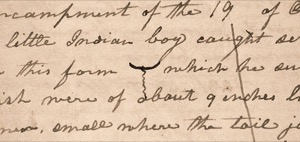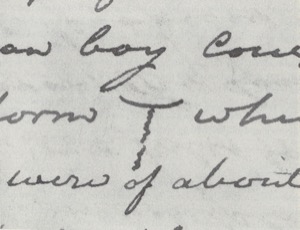April 26, 1806
[Lewis]
This morning early we set forward and at the distance of three miles entered a low level plain country of great extent. here the river hills are low and receede a great distance from the river this low country commence on the S. side of the river about 10 miles below our encampment of last evening. these plains are covered with a variety of herbatious plants, grass, and three speceis of shrubs specimines of which I have preserved. [1] at the distance of twelve miles we halted near a few willows which afforded us a sufficient quantity of fuel to cook our dinner which consisted of the ballance of the dogs we had purchased yesterday evening and some jirked Elk. we were overtaken today by several families of the natives who were traveling up the river with a number of horses; they continued with us much to our annoyance as the day was worm the roads dusty and we could not prevent their horses from crouding in and breaking our order of mach without using some acts of severity which we did not wish to commit. after dinner we continued our march through the level plain near the river 16 Ms. and encamped about a mile below three lodges of the Wollah wollah nation, [2] and about 7 Ms. above our encampment of the 19 of October last. after we encamped a little Indian boy caught several chubbs with a bone in this form [3] which he substituted for a hook. these fish were of about 9 inches long small head large abdomen, small where the tail joined the body, the tail wide long is proportion and forked. the back and ventral fins were equadistant from the head and had each 10 bony rays, the fns next the gills nine each and that near the tail 12. the upper exceeded the under jaw, the latter is truncate at the extremity and the tonge and pallet are smooth. the colour is white on the sides and belley and a blewish brown on the back. the iris of the eye is of a silvery colour and puple black.— we covered ourselves partially this evening from the rain by means of an old tent.
[Clark]
This morning early we proceeded on and at the distance of three miles entered a low leavel plain Country of great extent. here the river hills are low and receed a great distance from the river this low Country Comenced on the South Side about 10 miles below our Encampment of the last night, those plains are Covered with a variety of herbatious plants, Grass and 3 Species of Shrubs. at the distance of 12 miles halted near Some willows which afforded us a Sufficient quantity of fuel to cook our dinner which Consisted of the ballance of the dogs we had purchased yesterday evening and Some jerked Elk. we were over taken to day by Several families of the nativs who were traveling up the river with a Numr. of horses; they Continued with us much to our ennoyance as the day was worm the roads dusty and we Could not prevent their horses Crouding in and breaking our order of March without useing Some acts of Severty which we did not wish to Commit. after dinner we Continued our march through a leavel plain near the river 16 miles and encamped about a mile below 3 Lodges of the fritened band of the Wallah wallah nation, and about 7 miles above our encampment of the 19th of Octr. last. after we encampd a little Indian boy Cought Several Chubbs with a bone in this form [4] which he Substituted for a hook. those fish were of about 9 inches long. we Covered our Selves perfectly this evening from the rain by means of an old tent. Saw a Goat and a Small wolf at a distance to day. made 28 miles
[Ordway]
Saturday 26th of April 1806. we got up our horses. took a light breakfast of a little dry Elk meat and Set out proced on over a low level Smooth Sandy plain about 12 miles & halted & dined on a little dry Elk meat as we have nothing else. the day warm. we delayed about 1 hour and proceed. on a number of the natives followed us who are mooveing up the river & Some of them are going over the rockey mountn. to kill buffaloe. Saw considerable of Snow on the mountains to the South & S East. came 20 odd miles this day & Camped [5] on the bank of the river. only small willows to burn &C—
[Gass]
Saturday 26th. Last night Capt. Lewis and Capt. Clarke got each a horse, and we set out early, had a fine morning, and proceeded on very well, most of the men having their knapsacks carried on the horses. At noon we halted and took a little of our dried meat, which is the only food we have. At 2 o'clock we continued our journey, and the officers were obliged to go on foot again, to let some of the men ride whose feet were very sore. The country is level and has a most beautiful appearance. On the plains there is a species of clover, [6] as large as any I have seen, and has a large red handsome blossom. The leaves are not quite so large as those of the red clover cultivated in the Atlantic States, but has seven and eight leaves on a branch. We were overtaken and passed by a great number of the natives, with large droves of horses, that look well and are in good order. We travelled about 25 miles and encamped at a small grove of willows.




